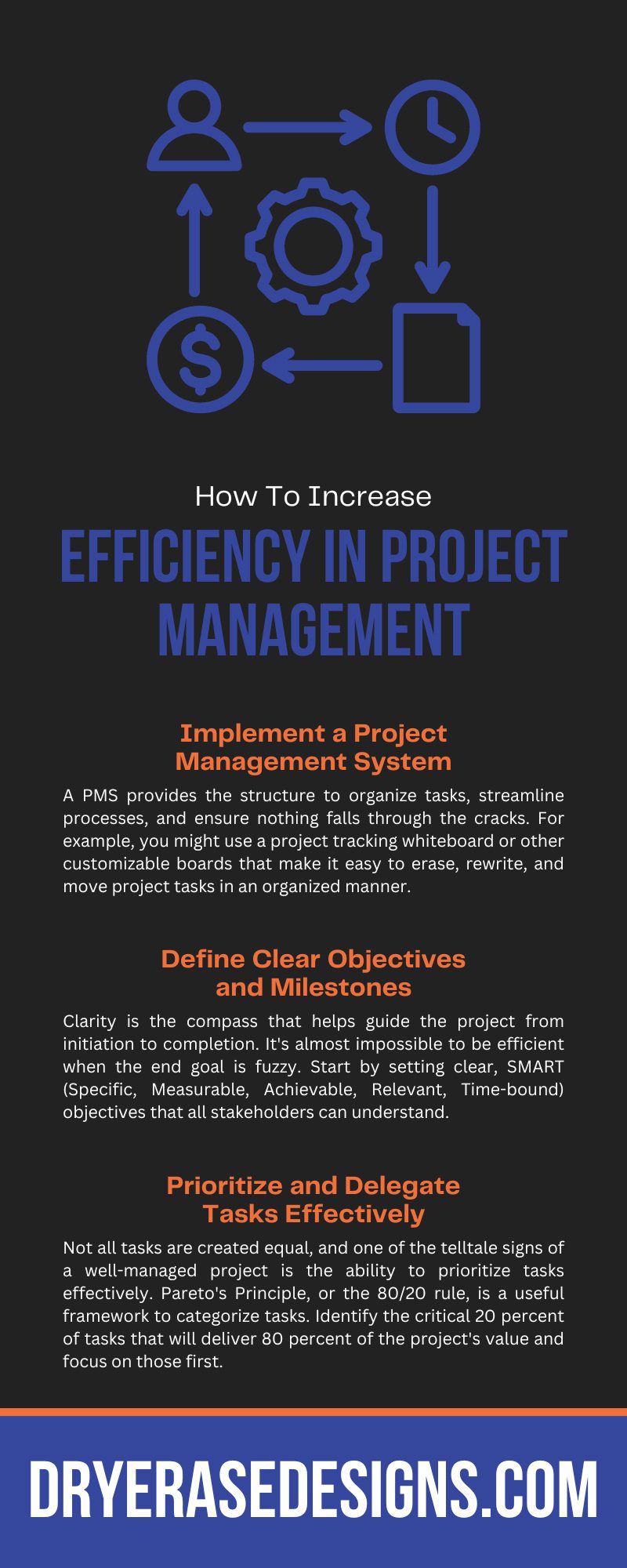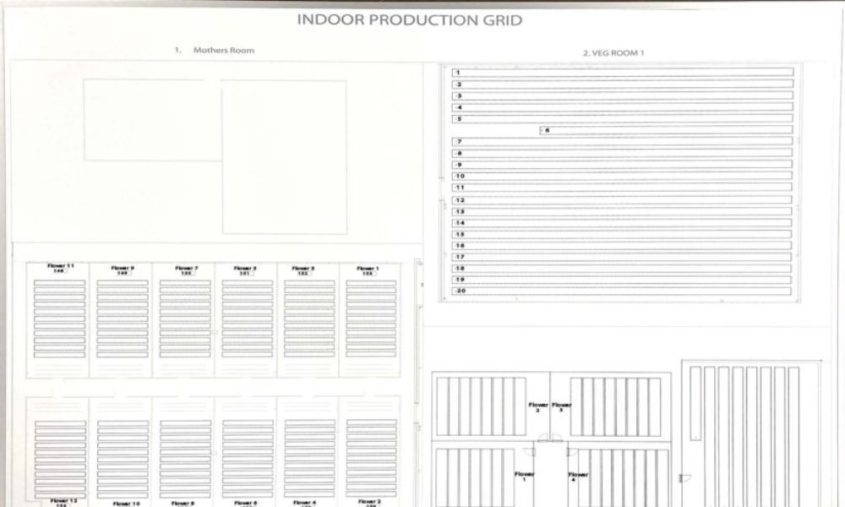How To Increase Efficiency in Project Management
Project management is the heartbeat of any successful enterprise, but keeping that pulse steady isn’t as simple as directing tasks and tracking timelines. It’s about orchestrating people, processes, and resources harmoniously. If you’re looking to increase efficiency in project management, our roadmap can help transform your processes from a series of chores to a strategic advantage. From implementing systems and defining objectives to investing in training and fostering positivity, we’ll cover a spectrum of tactics that will help you complete projects and innovate how you execute them.
Implement a Project Management System
Before diving into the nuanced strategies of efficiency, it’s crucial to establish a robust project management system (PMS). A PMS provides the structure to organize tasks, streamline processes, and ensure nothing falls through the cracks. For example, you might use a project tracking whiteboard or other customizable boards that make it easy to erase, rewrite, and move project tasks in an organized manner.
The system you choose should align with your project’s complexity and your team’s comfort level. Implementing a PMS enables you to centralize project data, which is essential for making informed decisions that can significantly boost efficiency. Remember that the tools you use are only as effective as your commitment to using them properly.
Define Clear Objectives and Milestones
Clarity is the compass that helps guide the project from initiation to completion. It’s almost impossible to be efficient when the end goal is fuzzy. Start by setting clear, SMART (Specific, Measurable, Achievable, Relevant, Time-bound) objectives that all stakeholders can understand.
Each objective should be accompanied by achievable milestones that can act as markers for progress. Well-defined milestones create a roadmap for your team, offering them a sense of direction and a series of achievements to celebrate throughout the project lifecycle.
Prioritize and Delegate Tasks Effectively
Not all tasks are created equal, and one of the telltale signs of a well-managed project is the ability to prioritize tasks effectively. Pareto’s Principle, or the 80/20 rule, is a useful framework to categorize tasks. Identify the critical 20 percent of tasks that will deliver 80 percent of the project’s value and focus on those first.
Effective prioritization also involves understanding your team’s strengths and workloads, which allows for proper delegation. Trusting your team with responsibilities not only relieves your workload but also empowers team members to take ownership and deliver their best work.
Employ Agile Methodologies
Incorporating Agile methodologies into your project management practices is another effective way to enhance efficiency. Agile is a flexible, iterative approach that focuses on collaboration, customer feedback, and small, rapid releases. Unlike traditional project management methods, Agile allows for continuous improvement throughout the project lifecycle, adapting quickly to changes and new insights.
One popular Agile methodology is Scrum, which organizes work in short sprints, typically lasting two to four weeks. These sprints allow teams to break down large projects into manageable tasks and focus on delivering specific features or products in each cycle. Scrum encourages regular reflection and adjustment, fostering an environment where efficiency is continuously improved.
Optimize Meetings and Communication
Meetings and communication can be a double-edged sword. When done right, they can align the team, foster creativity and innovation, and drive consensus. However, when not managed efficiently, they can become time-consuming and counterproductive.
To optimize meetings, ensure there’s a clear agenda, and stick to it. Limit the number of attendees to only those who are essential to the meeting’s objectives and encourage participation to keep everyone engaged. When it comes to communication, use a mix of synchronous and asynchronous methods, such as instant messaging and project management platforms. This allows team members to communicate without unnecessary delays.
Encourage Team Collaboration
Collaboration is the secret sauce of efficient project management. When team members work together, they can share the workload, problem-solve more effectively, and leverage each other’s expertise. Create an environment that is conducive to collaboration by breaking down silos and fostering a culture of open communication.
Cross-functional teams can bring different perspectives to the table and catalyze innovation. However, it’s important to ensure collaboration doesn’t lead to decisions by committee. Clearly define roles and responsibilities and empower team members to make decisions within their domains.
Monitor Progress and Adjust as Needed
An adept project manager constantly monitors the pace of a project and makes necessary adjustments to ensure smooth progress. Stay on top of progress by regularly reviewing metrics and reports. This allows you to identify potential bottlenecks early and take corrective action before they derail the project.
Adaptability is key in project management. Projects rarely unfold exactly as planned, and being prepared to make adjustments is critical. This might mean reallocating resources, changing timelines, or revisiting the project’s scope. Always be ready to pivot to ensure the project stays on track.
Invest in Training and Development
Investing in your team’s development is investing in your project’s efficiency. Equip your team with the tools and skills they need to excel in their roles. This could mean offering formal training programs, mentorship opportunities, or self-paced learning through online platforms.
Continuous learning improves individual performance and enhances the collective skill set of the team. By staying abreast of the latest industry trends and best practices, your team can work smarter and deliver better results.
Foster a Positive Work Environment
Efficiency thrives in a positive work environment. A team that feels supported, valued, and motivated is more likely to be productive. Leaders play a significant role in setting the tone for the team by exemplifying a positive attitude, showing appreciation, and providing support.
Celebrate wins, no matter how small, and learn from mistakes without assigning blame. Create a culture where taking calculated risks is encouraged and where failure is seen as a stepping stone to success. When team members feel safe to express their ideas and concerns, the project can benefit from their full engagement and creativity.
Beyond the Checklist
Efficiency is not a one-size-fits-all concept; it’s as much an art as it is a science. What works well in one project might be a misfit in another. The key is to approach efficiency in project management with a holistic view, acknowledging that it involves a combination of tools, methodologies, and human interaction.
By integrating the strategies to increase efficiency in project management outlined in this guide, you’re not just ticking off a checklist of best practices. You’re cultivating an efficiency mindset that becomes embedded in the very fabric of your projects and team dynamics. The path to efficiency is a continuous learning process. Pursue efficiency with the same vigor you apply to your project objectives, and you’re sure to elevate your performance as a project manager.





